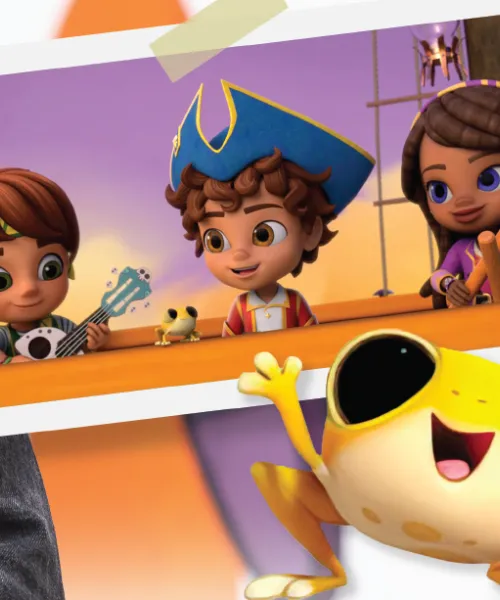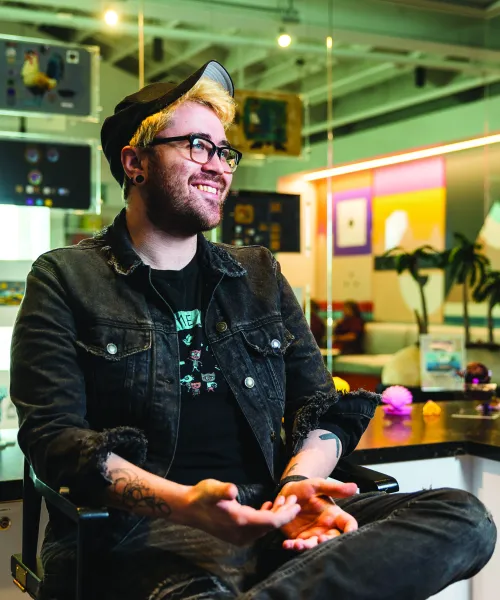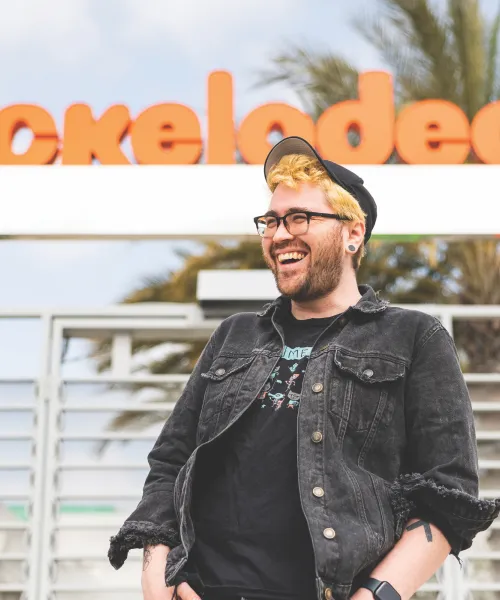By Rebecca Tavernini '11 MA
Josh McKenzie ’13 BFA never really thought of himself as an artist.
“I just really liked cartoons,” he said. “I saw a Garfield comic strip as a kid, and thought it would look so much better in color, so I colored it in. That was the first time I had an idea about contributing to the cartoon process.”
By middle school, though, he had convinced himself he couldn’t really draw. But the cartoons still drew him in.
“I would just let the TV play and keep watching. I was a huge Hey Arnold! fan. I loved Ed, Edd n Eddy and As Told by Ginger. I liked things that were slightly more grown up, with kids having problems they have to solve. Actually that’s still most of my interests!” said McKenzie, who is now a storyboard artist at Nickelodeon, the network that created cartoons and characters that have influenced generations, often made parents cringe (and then addicted them as well), spawned a media and merchandise empire and new lexicons, such as Opposite Day and “Happy, happy, joy, joy!” It was actually the first cable channel dedicated to children, launched, incredibly, way back in 1979. McKenzie started at "Nick," working on Santiago of the Seas, in the summer of Covid, after a colleague who had worked on the first season of the show had recommended him. “I was beyond thrilled,” McKenzie said, “because the reason I came to L.A. was cartoons. I was working toward it, and it didn’t happen quickly, but I was thrilled at the chance and glad that they took me. I work with a fun and positive crew, and in every experience there is a lot of mentoring.”
That experience is reflected in each episode of Santiago of the Seas, which follows the adventures of a brave and kind-hearted pirate Santiago, his frog sidekick Kiko, cousin Tomás and mermaid friend Lorelai. “It focuses on how they balance each other out and it celebrates differences between people. Even the villains are good!”
Storyboard artists create the blueprint for an animated production.
"It’s when we establish and translate everything from the script visually. It shows each shot, shot placement, how to make it look like a cartoon and what filmmaking techniques to use. The boards are very much the beginning of the episode, so we have to be mindful of the design and animation teams who will get them next.”
Several storyboard artists will work on a production, under a director. Different sections of an episode are broken up and assigned to multiple “pods” of 4-7 people who interpret the story visually, emotionally and thematically. “Then we have to fit it all together in the end,” said McKenzie. “There’s a constant ongoing dialogue. That can be tricky, especially if you really love something or it took a lot of time, and it doesn’t make the cut.”
It generally takes about six weeks to storyboard one 20-minute episode.
All animation happens in the building that Josh works in. It is one of three that are connected on the Nickelodeon campus in Burbank, where around 700 employees work on 20 shows. The buildings are bright white with giant Nickelodeon letters emblazoned in its trademark orange. Green slime appears to ooze off the roof on which large character figures play. In the courtyard, totem poles depict favorite faces from Blue’s Clues, Hey Arnold!, Fairly OddParents, Rugrats and other classic Nick shows. There’s a giant pineapple (under the sea) near an entrance gate, inhabited by a security guard. A whimsical atmosphere of creativity and fun permeates the block and interior collaborative work spaces.
Likewise, Santiago’s world is infused with vibrant Caribbean culture and traditions. “It’s so cool for someone who didn’t grow up with that to see it in such a fun and colorful way,” said Josh.
For the Flint native, that is quite a contrast. As was heading to the U.P. to attend NMU. “After my friends encouraged me to get back into art in high school, I had mostly kept my sketchbooks to myself, so when I told my parents I was going to Northern and majoring in illustration, they said, ‘Since when?!’ But I couldn’t imagine going into any other career.
“I knew I couldn’t afford a fancy art school. A friend said that Northern has such great facilities and a great art school and was affordable. So I visited and it was pretty much love at first sight. It’s so hard not to love the lake and the forest and be surrounded by so much nature. I was definitely not an outdoorsy kid! But Lake Superior was an excellent resource to draw and look at and spend time by.” In watching Santiago’s ship sail on the rolling seas one can see that influence.

Santiago of the Seas characters Tomás, Santiago, Lorelai and Kiko the frog (artwork courtesy of Nickelodeon)
McKenzie found that Marquette and NMU felt like a big and small community at the same time, and he created and found his place in both realms. He was “the desk guy" at the DeVos Museum and at the Student Art Gallery, and thanks then gallery director Melissa Mutuscak ’02 BFA for opening doors for him to later land jobs at Chicago’s seminal Museum of Contemporary Art and at Nucleus Gallery in L.A.
“My illustration professor Steven Hughes was fantastic. And I loved Tracy Wascom’s theory classes. I had a Russian literature course, and instead of writing a paper, I illustrated scenes from it, so my professor thought it was a novel approach and he recommended me for a job at the Writing Center, which is actually where I worked the longest, for several years, and loved it.”
McKenzie and Stefanie Anttila ’13 BFA started the Student Illustrator Syndicate, “because people in the illustration program needed it the most because they’re the shyist! They didn’t know how to say ‘Hi’ in class—and drawing is very solo because you only need one person to do the job.” They would watch animated films together (and maybe talk!). The group is still active at NMU today.
“The biggest thing was that Northern gave us students so much freedom. Faculty were open to us cross-collaborating, to experimenting, to learning other media and being able to play around. To come into my own and learn to think of myself as an artist, that was one of the most valuable things. That was fostered at NMU.”
Josh, who also has a freelance career as a comic book artist, and Santiago, are empowered by a freedom to be themselves. “What excites me not just about storytelling, but looking at art, is the feeling of vulnerability and honesty. I try to go there, and encourage others to.”
Looking around the room at Nickelodeon, with digital storyboards on glass walls, Santiago books and pirate ships and stuffed dolls surrounding us, he added, with a huge smile, “It’s cool to be here. It’s cool to see the cartoon become toys. It’s hard not to buy them all!”

